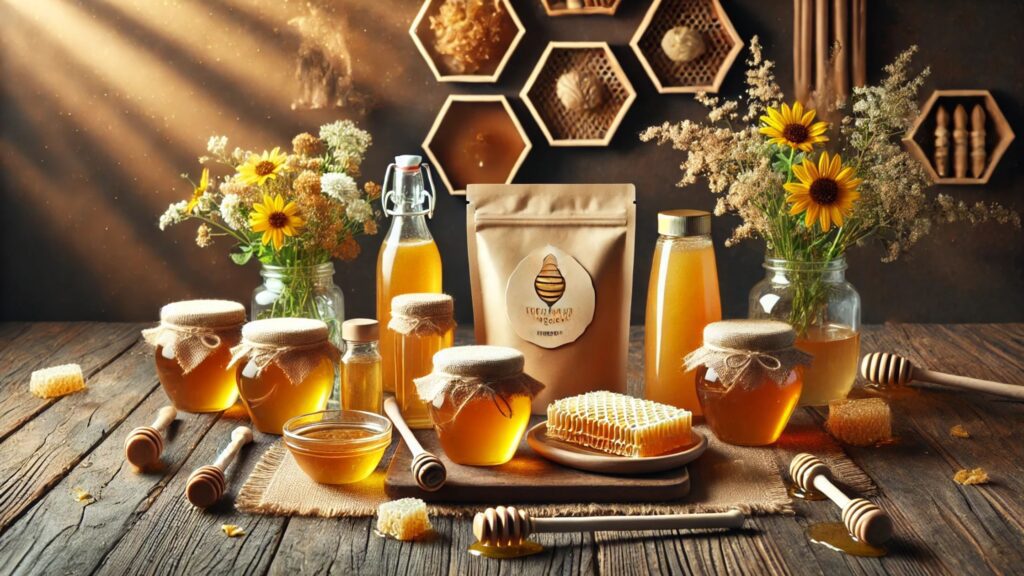Honey packaging is more than just an aesthetic choice—it plays a crucial role in preserving the quality, purity, and flavor of this natural sweetener. Whether you’re a beekeeper, a small business owner, or a large-scale honey producer, selecting the right packaging is essential for both marketing and product integrity.
Importance of Honey Packaging
Honey is a sensitive product that can crystallize, absorb moisture, and lose its aroma if not properly stored. High-quality honey packaging ensures:
- Protection from Contaminants: Proper sealing prevents exposure to air, moisture, and bacteria.
- Extended Shelf Life: Airtight packaging helps maintain the honey’s consistency and flavor.
- Branding and Market Appeal: Attractive packaging enhances product visibility and consumer trust.
Types of Honey Packaging
There are several materials and designs to choose from when it comes to honey packaging. Here are some of the most popular options:
1. Glass Jars
Glass jars are a traditional and premium choice for honey packaging. They provide excellent visibility, allowing customers to see the golden richness of the honey. Additionally, glass is non-reactive and helps preserve the honey’s natural properties. However, they can be fragile and heavier than other options.
2. Plastic Bottles
Plastic squeeze bottles are convenient and user-friendly. They make it easy for consumers to dispense honey without mess. PET (Polyethylene Terephthalate) and HDPE (High-Density Polyethylene) plastics are commonly used because they are food-safe and lightweight. However, some consumers prefer eco-friendly alternatives due to concerns over plastic waste.
3. Eco-Friendly Packaging
With the rising demand for sustainable solutions, eco-friendly honey packaging options such as biodegradable pouches, recyclable glass, and compostable containers are gaining popularity. These options appeal to environmentally conscious consumers and help reduce the carbon footprint.
4. Custom-Designed Packaging
For premium honey brands, custom-designed packaging can create a unique identity. Embossed jars, wooden lids, or minimalist labels can elevate the brand’s image and attract more customers.
Key Considerations for Honey Packaging
When choosing honey packaging, keep these factors in mind:
- Material Safety: Ensure the packaging is food-grade and does not alter the taste or quality of honey.
- Ease of Use: Customers appreciate convenient, mess-free dispensing.
- Aesthetic Appeal: The packaging design should align with your brand identity and attract potential buyers.
- Sustainability: Opting for recyclable or biodegradable materials can enhance brand reputation and meet consumer expectations.
Conclusion
Honey packaging is a blend of functionality and branding. The right choice not only protects the honey but also enhances its market appeal. Whether opting for traditional glass jars, convenient plastic bottles, or sustainable alternatives, businesses should prioritize quality, design, and environmental impact. Investing in thoughtful honey packaging ensures that consumers enjoy nature’s sweetness in its purest form while supporting a brand they trust.
Related Articles
- The Art and Science of Packaging | Trends, History & Future
- The Future of Takeaway Packaging: Sustainable and Innovative Solutions
- What Is Primary Packaging? A Complete Guide
- The Future of Manufacturing: Primary Packaging Automation
- Chocolate Primary Packaging: Ensuring Freshness, Safety, and Appeal
- Pharmaceutical Primary Packaging: Ensuring Safety and Efficacy
- Primary Packaging Examples: Understanding Their Importance
- Primary Packaging vs Secondary Packaging: Understanding the Differences
- The Future of Smart Packaging: Innovation at Its Best
- The Importance of Industrial Packaging in Modern Supply Chains

